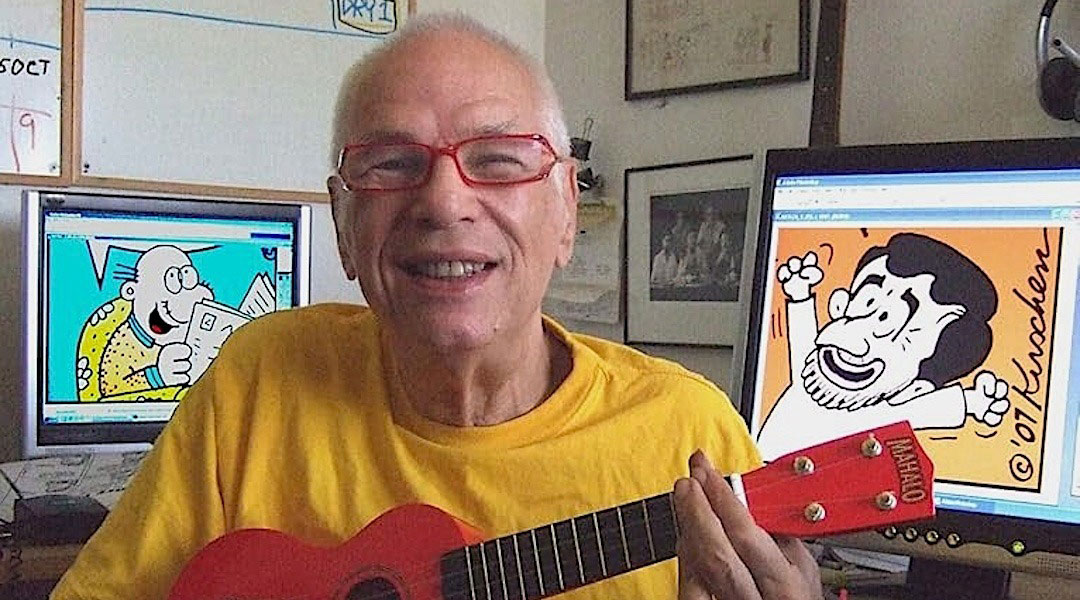Courtesy of JTA. Photo credit: Image via amazon.com
Yaacov Kirschen drew his “Dry Bones” comic strip, which at one point ran in 35 newspapers around the world, for over 50 years
By Andrew Silow-Carroll
(JTA) — Yaakov Kirschen’s first cartoon was published in the Jerusalem Post on Jan. 1, 1973. The comic, called “Dry Bones,” starred a Ziggy-like character named Shuldig, a bald and bristly everyman, and his dog Doobie.
I first read Dry Bones in Hebrew school, when it served as an American Jewish teen’s introduction to the mild kvetching and occasionally pointed political musings of an average “Anglo” Israeli — that is, an immigrant from an English-speaking country, like Kirschen.
Up until nearly the day he died last month at 87, Kirschen kept at it, portraying such Israelis — for good and for ill — to a mostly English-speaking audience.
A typical “Dry Bones” cartoon was sparsely drawn, with Shuldig speaking directly to the reader, or chatting with Doobie. “With ten terrible plagues we were brought out of Egypt,” Shuldig says in one cartoon, to which Doobie replies, “…and the UN was not there to condemn us?”
His work extended beyond the four-panel cartoon, and included a “Dry Bones” Haggadah, graphic novels and, in 2004, The Dry Bones Project, a nonprofit with the goal of combatting the “lies and ugliness” of anti-Semitism through humor. (In 2006 he gave out “Shmendrik” awards to those who “have most distinguished themselves by their seemingly unwitting support of antisemitism.”) In 2014 he won the Bonei Zion (“Builders of Zion”) prize from Nefesh B’Nefesh, a group that encourages Jewish immigration to Israel.
In 1994, Kirschen found an unexpected audience when born-again Christians embraced his graphic novel “Trees…The Green Testament.” The book is a history of Israel told from the perspective of its trees, and, according to a front page article in the Wall Street Journal, unintentionally illustrates “several biblical signs that evangelical Christians believe will presage the Second Coming. Among them: Jews will return to Israel, Israel’s hills will be planted with trees, and its barren land will bloom.”
Kirschen, something of an agnostic, was baffled by but ultimately grateful for the attention, appearing on Christian radio and television shows.
The Kirschen cartoon I remember best was drawn during the First Gulf War, when Israelis were issued gas masks and built air-tight “safe rooms” against the possibility of a chemical weapons attack by Saddam Hussein. Israel was targeted with missiles but ultimately spared, and Kirschen imagined a new Jewish holiday in which worshippers wear replica gas masks and have a big dinner in rooms symbolically draped in plastic sheeting. Considering the actual Jewish holidays that turn near annihilation into festive ritual — essentially, as the old joke goes, all of them — the idea was not as far-fetched as it seemed.
Kirschen’s increasingly nationalist politics were not to everyone’s liking, but until the end he captured the Israelis and American Jews who either never accepted or have grown weary of “peace” talk, are angry at the Israelis and outsiders who criticize the government and are convinced that the current war is another chapter in the existential fight for Jewish survival.
He expressed all of this in the wake of the Hamas attacks of Oct. 7, 2023, but also drew a few panels with a more wistful tone — expressing confidence that the war had united Israelis with a sense of common purpose.
Kirschen suffered a stroke earlier this year, and on his blog his wife, the artist Sali Ariel, chronicled his health challenges and decline. With the help of a graphic designer friend, “Yaakov is keeping on occasionally doing his cartoons,” she wrote on April 14. “He feels the calling to be able to help fight for the cause of the Jewish People with his satirical cartoons.”
He died later that day at a hospital near his home in Kfar Saba.




